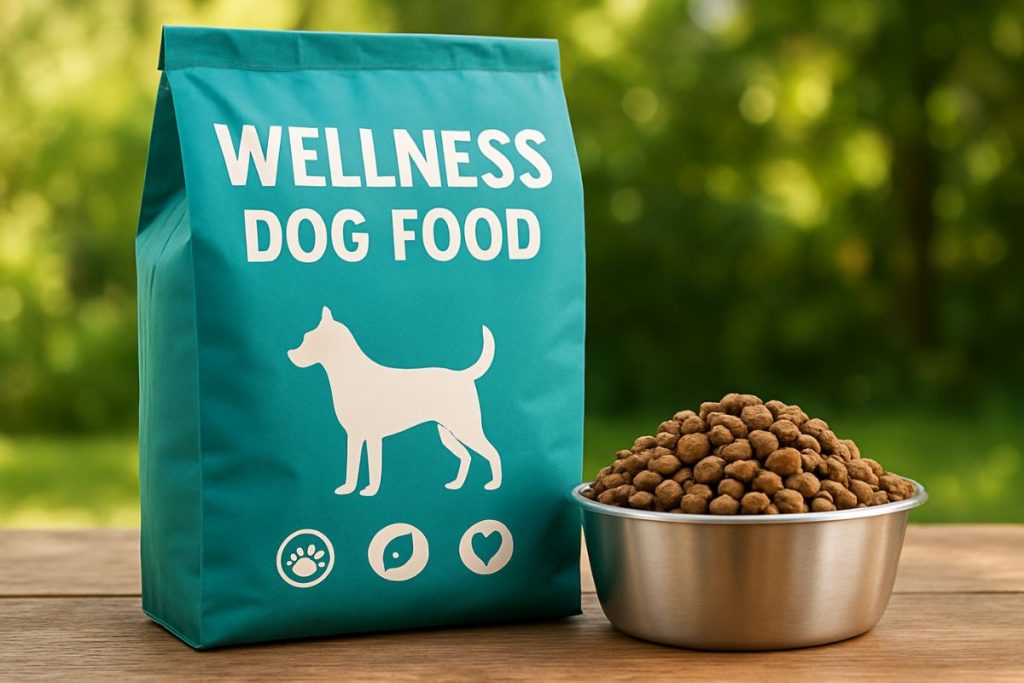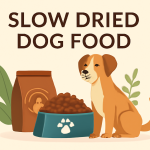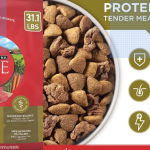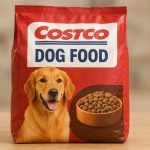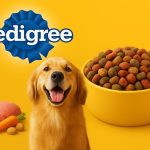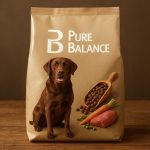Meta Title: Grain Free Dog Food: Balanced Nutrition for Pets
Meta Description: Balanced, grain-free diets for dogs with high-quality nutrition. Explore top dry dog food like Nutro, Canidae, and Orijen for optimal pet wellness.
Grain Free Dog Food: Balanced Nutrition for Pets
A beagle dog enjoying a balanced, nutritious meal from a metal bowl outdoors, illustrating high-quality grain free dog food and pet wellness. Dogs thrive on balanced nutrition, which means every meal provides the right mix of proteins, fats, carbohydrates, vitamins, and minerals. According to pet food experts, “Complete” pet food contains all required nutrients, and “Balanced” means those nutrients are in the correct ratiosaafco.org. For example, Wellness Pet Food’s “Complete Health” recipes are crafted to support the “Five Signs of Wellbeing” – sustained energy, digestion, healthy skin/coat, immune health, and strong bones – by using high-quality ingredients and complete nutritionwellnesspetfood.com. In this guide, we explain how to feed your dog a nutritionally balanced diet and where grain free dog food fits in. We’ll cover the science of canine nutrition, the pros and cons of grain-free diets, and highlight top dry dog food brands (including Nutro, Canidae, and Orijen) to help you choose the best dry dog food for your pet.
Dog owners now view pets like family, and nearly 68 million U.S. households own at least one dog (as of 2025)petfoodindustry.com. With such a large population of dogs, demand for high-quality pet nutrition is booming. Giving dogs balanced, natural dog food supports their health and longevity. Below we delve into what makes a diet truly nutritious for dogs, how to incorporate grain-free options wisely, and tips to pick the right dry dog food for your pup.
The Importance of a Balanced Diet for Dogs
A dog’s diet should be “complete and balanced” for its life stage and conditionaafco.org. This means it must supply all needed nutrients in proper proportions. Essential components of a healthy dog diet include:
- High-quality proteins: Real meats (chicken, beef, lamb, fish) provide amino acids for muscle growth and repairnutro.com. (Ingredients lists should list a meat or meat meal first.)
- Healthy fats: Omega-3 and omega-6 fats (from fish oil, flaxseed, etc.) support a shiny coat, healthy skin, brain function and immune healthwellnesspetfood.com.
- Complex carbohydrates & fiber: Whole grains (brown rice, oats) or vegetables supply energy, fiber and nutrients. Grains like rice or oatmeal can promote digestion and energypetmd.com. Fiber from grains and vegetables also helps maintain digestive healthpetmd.com.
- Vitamins & minerals: Fruits, veggies and added supplements (vitamins E, zinc, calcium, etc.) help bones, teeth, nerves and immunity. A balanced blend of vitamins and minerals is critical for overall healthwellnesspetfood.comaafco.org.
- Prebiotics and probiotics: These support healthy digestion and gut health (part of Wellness’s 5 wellbeing signs)wellnesspetfood.com.
Feeding guidelines: Always look for an AAFCO statement on the package stating the food is “complete and balanced” for your dog’s species and life stageaafco.org. Also follow portion guidelines on the bag, and adjust amount as needed to keep your dog at a healthy weightaafco.org. Remember, a growing puppy needs different nutrient ratios than an older adult dogaafco.org. Check “all life stages” labels carefully: they often list different feeding amounts for puppies vs adultsaafco.org.
To summarize, a well-formulated dog kibble should read like a healthy recipe: mostly meat, some whole grains or veggies, and no unnecessary fillers or artificial additives. Canidae Pet Food, for example, advertises “nutrient-rich recipes with premium proteins and farm-grown veggies, balanced for whole body health”canidae.com. Nutro likewise emphasizes real proteins (#1 ingredient) and no corn, wheat or soynutro.com. These standards ensure your dog gets complete nutrition for vitality.
Understanding Grain-Free Dog Food
Grain-free dog food eliminates common cereal grains (corn, wheat, rice) and replaces them with other carbohydrate sources (legumes like peas and lentils, potatoes, or alternative flours). Many owners choose grain-free diets believing they are more “natural” or hypoallergenic. Indeed, dogs evolved as carnivores and can digest grains, but some dogs benefit from grain-free formulas if they have specific sensitivities. PetMD notes that if a dog has confirmed grain allergies or intolerances, feeding a limited-ingredient or grain-free diet (often called a “novel protein” diet) can help reduce symptomspetmd.com. These diets use carefully tested recipes to avoid cross-contamination and known allergens, potentially reducing gastrointestinal flare-ups.
However, grain-free is not inherently “better” for every dog. In general, grains are a wholesome source of nutrients. PetMD explains that “dogs benefit from grains in their diet” – they supply essential nutrients, energy and fiber, promote healthy digestion and contribute to a robust immune system and strong musclespetmd.com. For healthy dogs without grain allergies, conventional formulas with whole grains can offer these benefits. In fact, grains contain vitamins and minerals valuable for pets, and most dogs tolerate them wellpetmd.competmd.com.
Pros and Cons of Grain-Free Diets
- Pros: Grain-free foods often use high-quality proteins and alternative carbohydrates (e.g., sweet potato, peas). They can be useful for dogs with documented grain sensitivities or food allergies, as eliminating common allergens may improve skin or digestive issuespetmd.com. Some grain-free formulas have higher meat content and added fats (like fish oils), which can boost energy and coat condition. Certain premium brands (like Orijen, discuss below) produce grain-free recipes that mirror a dog’s natural diet with high protein.
- Cons: Grain-free diets have been scrutinized for potential health risks. Recent research noted that many cases of canine heart disease (dilated cardiomyopathy, DCM) involved dogs eating grain-free foods high in peas or lentilspetfoodindustry.com. In a 2018-2019 FDA investigation, “93% of the 524 reported cases of DCM involved dog foods made with peas and/or lentils, and 90% of the afflicted dogs had eaten diets labeled as grain-free”petfoodindustry.com. This finding led many vets to question whether too many legumes or a lack of certain grains might contribute to heart issues. It’s important to note that correlation is not proven causation; scientists caution the evidence is not conclusivepetfoodindustry.com. Regardless, these findings prompted pet food makers to reformulate some foods with added taurine and whole grains to be “grain-friendly” rather than strictly grain-freepetfoodindustry.com.
In short, grain-free dog food can be part of a balanced diet if chosen carefully. Pet nutritionists recommend ensuring the diet is truly needed and nutritionally complete. For most dogs, grains are not harmful; for those with special needs, limited-ingredient or grain-free formulas can be helpful. Always consult your veterinarian before changing diets, especially if considering grain-free options.
Top Dog Food Brands for Balanced Wellness
Nutro Dog Food
Nutro (Mars Petcare brand) is known for its natural, balanced recipes. Nutro emphasizes “top-quality, nutritious pet food with trusted ingredients”nutro.com. All Nutro dry formulas use real proteins (chicken, beef, lamb, etc.) as the first ingredient and avoid artificial preservatives, flavors, and common fillers (no corn, wheat, soy, or by-product meals)nutro.com. For example, Nutro’s Natural Choice line is formulated around high-quality meats and wholesome ingredients. DogFoodAdvisor rates Nutro’s grain-inclusive recipes highly: “Nutro is a quality, grain-inclusive kibble… earning the brand 4.5 stars”dogfoodadvisor.com. (Nutro also offers grain-free lines like Nutro Ultra for sensitive dogs.) In practice, Nutro dog food provides balanced nutrition with moderate protein (~27% dry matter) and fats, and it often includes flaxseed or chia for omega-3 fatsdogfoodadvisor.com. Owners report healthy coats and energy on Nutro diets.
Canidae Dog Food
Canidae offers a wide range of balanced diets for all life stages. The company mission is “nutrient-rich recipes featuring premium proteins and farm-grown veggies, balanced for whole body health”canidae.com. Canidae recipes start with real meat (chicken, beef, fish) and include vegetables (e.g. sweet potatoes, peas, carrots) or grains (brown rice, oatmeal) for energy and nutrients. Many Canidae lines are grain-free (PURE grain-free line) or limited-ingredient for sensitive dogs. Independent reviews praise Canidae for good digestibility and energy: customers note “high quality with great ingredients” and healthy coats after switching to Canidaetalis-us.com. Canidae explicitly markets that its formulas support coat condition, digestion, and overall health by combining clean ingredients (no corn/wheat fillers) and rich proteintalis-us.com. If your dog has allergies or sensitive stomach, Canidae’s PURE Limited Ingredient line might suit. As Canidae reports on its site, switching to their balanced recipe resolved a puppy’s allergies when other kibbles didn’tcanidae.com.
Orijen Dog Food
Orijen (by Champion Petfoods, Canada) is a premium grain-free brand with very high protein. Orijen recipes emphasize biologically appropriate nutrition, using up to 85% animal ingredients (meat, organs, fish) and no cheap carbsorijenpetfoods.com. Orijen does not use grains in its core diets – instead it uses things like lentils, chickpeas, and vegetables. The brand touts fresh or raw ingredients to mimic a dog’s ancestral diet. Its Wikipedia page notes Orijen is a premium dog food brand, now owned by Mars (as of 2023)en.wikipedia.org. Many consider Orijen among the “best dry dog foods” for highly active dogs needing dense nutrition. However, its high meat formula may be more protein- and fat-heavy than typical kibble, so portion control is important. Orijen’s high-meat, no-grain approach can benefit dogs needing lean muscle support, but owners should ensure it meets their dog’s specific nutrient balance (sometimes adding a grain-inclusive topper can balance a very rich diet).
Other Well-Regarded Dry Foods
Several other brands deserve mention in the context of balanced pet nutrition:
- Wellness Complete Health: Wellness’s own brand of dog food (“Complete Health” line) is formulated to support overall well-being (the 5 signs)wellnesspetfood.com. These recipes include quality proteins and either wholesome grains or grain-free options, plus probiotic fibers. Many owners find dogs thrive on Wellness formulas, with improved coat and energy.
- Blue Buffalo, Merrick, Taste of the Wild, and Royal Canin (breed-specific formulas) are other examples of premium, veterinarian-formulated diets that focus on complete nutrition. Each balances meat proteins with carefully chosen carbohydrate and fiber sources. (Check labels: Blue Buffalo uses brown rice, oatmeal, or sweet potato, for example.)
- BEST dry dog food choices depend on your dog’s life stage, breed, and health needs. Look for brands that explicitly meet AAFCO standards and use high-quality ingredients (as above). Comparing several top-rated formulas can help: many pet food review sites list the highest-rated kibble.
Above all, the best food is one your dog digests well and maintains in lean condition. Both grain-inclusive and grain-free premium foods can be excellent. The key is balance: protein, fat, and fiber must meet your dog’s energy needs.
How to Choose the Best Dry Dog Food (Checklist)
When selecting a dry dog food for wellness, follow these steps:
- Check the “Complete & Balanced” Statement: Ensure the food meets AAFCO guidelines for your dog’s life stage (puppy, adult, senior)aafco.org. The package should explicitly say it is formulated for that life stage.
- Examine the Ingredients List: The first ingredients should be named meats (e.g., “chicken,” “lamb,” “salmon”). Avoid foods with vague meat sources or lots of cheap grains (corn, wheat). Nutro and Canidae, for instance, list real meat firstnutro.comcanidae.com.
- Consider Protein and Fat Levels: Look at the guaranteed analysis. Active or working dogs often do well on higher protein (25–30%) and fat (15–20%) kibbles (like Orijen). Less active or weight-prone dogs may need moderate levels.
- Identify Special Needs: If your dog has allergies, sensitivities, or is a picky eater, choose accordingly. Grain-free or novel protein diets (like lamb & rice, fish-based, or “limited ingredient”) can help allergic dogspetmd.com. Overweight dogs may benefit from formulas labeled for weight management.
- Look for Added Nutrients: Good kibbles often include glucosamine (for joints), taurine (for heart health), probiotics (for gut health) and antioxidants. For example, Wellness includes probiotic fiber for digestionwellnesspetfood.com, while Nutro adds plant sources of omega fatsdogfoodadvisor.com.
- Avoid Fillers and Additives: Steer clear of artificial colors, flavors, or low-cost fillers. Nutro’s marketing highlights “no artificial preservatives or flavors… and no corn, wheat, or soy protein”nutro.com. Ingredients like beet pulp or tomato pomace are debated fillersdogfoodadvisor.comdogfoodadvisor.com – small amounts are OK, but they shouldn’t dominate the recipe.
- Consult Reviews and Vets: Look at unbiased reviews (e.g., DogFoodAdvisor) and talk to your veterinarian. Expert reviews often rate formulas on digestibility, stool quality, and ingredient quality. For instance, reviewers describe Nutro and Canidae as “quality,” praising their ingredient listsdogfoodadvisor.comtalis-us.com.
Example (Numbered List): Steps to switch your dog’s food safely:
- Gradually mix a little of the new food with the old over 7–10 days.
- Start with 25% new food, increasing by 25% every 2–3 days.
- Watch for digestive upset or refusal at each stage.
- If issues arise, slow the transition or try a different formula.
By following this checklist, you ensure your dog’s dry food choice delivers balanced wellness and avoids common pitfalls.
Frequently Asked Questions (FAQ)
Q: Is grain-free dog food healthier than grain-inclusive formulas?
A: Not necessarily. Grain-free isn’t inherently healthier; it’s just different. Most healthy dogs do well on diets with whole grains, which supply energy and nutrientspetmd.com. Grain-free diets can be useful for dogs with grain allergies or stomach sensitivities, but they often use peas or lentils instead. Veterinarians caution that many cases of canine DCM (a heart condition) were reported in dogs on grain-free dietspetfoodindustry.com. The USDA’s FDA found “most of the diets associated with DCM cases have legume seed ingredients (pulses) in high amounts,” affecting both grain-free and grain dietsfda.gov. In short, only choose grain-free if your vet advises it; otherwise, focus on overall nutrient balance.
Q: What makes a dog food “premium” or “high quality”?
A: Premium dog foods use high-grade ingredients, like named meats (chicken, lamb) and real fruits/vegetables, with fewer fillers. They avoid artificial additives and often add functional nutrients (probiotics, omega oils, joint support). Brands like Nutro and Canidae highlight natural ingredients; for example, Nutro recipes center around “high-quality protein sources and wholesome ingredients rooted in nature”nutro.com. Such foods typically meet AAFCO standards and have good digestibility. You’ll see stool size and energy levels improve on high-quality kibble.
Q: How can I tell if a dog food is nutritionally balanced?
A: First, check the label for an AAFCO compliance statement. Second, look at the ingredient and analysis panels: a balanced diet should have appropriate levels of protein, fat and fiber for your dog’s life stage. Trusted sources like the AAFCO site explain that “Balanced” means the nutrients are present in the correct ratiosaafco.org. Balanced formulas often list multiple protein sources and include a mix of grains/veggies plus added vitamins/minerals. If needed, consult a veterinary nutritionist to verify the formula meets your dog’s needs.
Q: Can switching to a grain-free diet change my dog’s coat or energy?
A: It can, but usually because of the overall ingredient quality rather than grain removal. Dogs on diets rich in omega-3s (e.g., from fish oil or flaxseed) often show shinier coats. Many high-end grain-free foods happen to be rich in healthy fats, which benefits skin and coatwellnesspetfood.com. Similarly, protein- and fat-rich diets can boost energy, especially in active dogs. However, a grain-inclusive premium food can provide similar benefits. The key is a balanced formula with quality fats and proteins – not just the absence of grains.
Q: What’s the role of dry food vs. wet food in nutrition?
A: Dry kibble is convenient and helps keep teeth clean, but it has lower moisture. It’s ideal as the main diet for many dogs (especially large breeds). Wet food adds hydration and often more palatable taste/texture. Mixing dry and wet can give the best of both (as Nutro suggests, for example)nutro.com. Just adjust portions: wet food is calorie-dense with water, so you might feed a bit less dry if mixing. Whether dry, wet, or a combination, ensure the overall diet remains balanced and complete.
Conclusion
A well-balanced grain free dog food can be a healthy choice when formulated properly, but it’s not a cure-all. The priority is whole-body wellness through complete nutritionwellnesspetfood.com. Look for dry dog foods that meet AAFCO “complete and balanced” criteria, start with real meat ingredients, and avoid unnecessary fillers or artificial additivesnutro.comaafco.org. Brands like Nutro and Canidae exemplify this approach by using premium proteins and wholesome grains or veggies to deliver all essential nutrientsdogfoodadvisor.comcanidae.com. Likewise, high-protein brands like Orijen focus on species-appropriate diets, though their extreme formulations (grain-free, very high meat) should be chosen based on your dog’s needs.
Ultimately, the best dry dog food for your pet supports their energy, healthy coat, strong muscles and happy tummy. Combining expert guidance with high-quality ingredients is key. If you’re curious about grain-free options, consult your vet, and consider a gradual switch to monitor your dog’s response. Remember to encourage variety in their diet (mixing toppers or wet food is fine) and keep an eye on their weight and vitality.
Call to Action: Love your dog’s new diet? Share this article with fellow dog owners on social media! And leave a comment below to tell us which grain-free or balanced dog food your pet enjoys the most. Your feedback helps the community make informed nutrition choices.
Sources: Authoritative pet nutrition and industry sources were used to ensure accuracy

